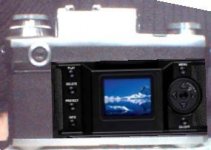jlw
Rangefinder camera pedant
BJ Bignell said:I don't have much intelligent to add to this thread right now, but I found it interesting, and fun to read thus far. So, my 2 cents:
I find one solution proposed by jlw - to have a servomotor-based rangefinder - very interesting; this might even help to solve the problem of misaligned rangefinders. It would even be relatively easy to make this type of system self-healing. Imagine this: mount camera on tripod, set lens to infinity, and then press a button until the rangefinder patch lines itself up correctly. Repeat for 1m, and you're set. Have another button to adjust the vertical, and you're laughing. I would welcome this, as I have two Bessa R that currently need slight adjustment in both directions!
Yup, that type of thing should be feasible. More to the point for manufacturers, it should be possible to do the alignment settings robotically, rather than requiring each camera to be hand-calibrated by a technician.
About replacing the lens mount, I don't know what to say... maybe it's because I'm not sure I see the need to change.
For film-camera use, I agree there's no need to change. For digital-camera use, I think the M mount's short backspacing is going to be a perpetual roadblock, because the lens' "chief ray angle" (angle at which rays from the lens reach the sensor) is always going to be steeper than optimum.
Leica has pretty much conceded this in their approach with the M8 to vignetting, antialiasing, and infrared contamination. They've addressed the vignetting issue with their offset microlenses, but they're on record as saying that a truly effective IR-cut filter behind the lens would have had to be so thick that it would have caused color fringing by displacing the steeply angled rays; instead, they want you to install the IR-cut filter over the lens when needed. They've also said that's one reason why they didn't fit an anti-alias filter to the M8. M8 enthusiasts are willing to accept all this, but there's no denying that it makes things more complicated than with DSLRs that can produce excellent results without resorting to these workarounds -- simply because the lens is farther from the sensor.
Personally, I think that if a new system arrives, it must include compatibility for M (and thus, LTM) lenses if it wishes to succeed with the current customer base. And personally, if it results in a significantly larger camera (not larger like an M5, but larger like a 5D), I'm not going to be interested.
Oddly enough, my train of thought got started on this when (in another thread) I imagined a fantasy "Canon 7sD" digital RF camera. My idea for this camera was that it would be about the size of the original Canon 7s (chunkier than a Leica, but not huge) and that it would contain Canon's EOS 5D sensor and electronics plus an electronically-coupled RF system.
The idea was that the basic body would have an M-mount that would accept current M lenses (using a distance encoder in the body to read out the RF coupling arm.) It also would also come with a "Lens Mount Converter D" (to adopt Canon's old terminology) similar to the ones they used to sell that allowed their SLR lenses to be mounted on their RF cameras. This converter would be of the right thickness to space EOS lenses correctly on the camera, and would contain all the electronic contacts needed to operate an EOS lens.
The idea was that they could add electronic distance encoders (this would be quite inexpensive) to a selected RF-friendly range of their EOS lenses -- say, the 28/1.8, 35/1.4, 50/1.2, 85/1.2, and 100/2. These lenses would still work normally as-is on Canon DSLRs (making it cost-effective to build them; they wouldn't need to make a separate range of limited-market RF lenses) but also would provide full electronic RF coupling on the "7sD" body through the lensmount converter.
How would you like them apples?!?!?
[Incidentally, in principle there's no reason the same couldn't be done with the Nikon lens mount, if it were restricted to their latest lenses with built-in focusing motors.]
From the responses to my earlier posts, I know some people would read this and say, "Why not just buy an EOS 5D instead?" My answer: "Because this would be a rangefinder camera! Rangefinder focusing and viewing just plain works better than SLR focusing and viewing for some types of photography!"
It continues to baffle me how many people here on RangeFinder Forum just don't seem to "get" that...
Last edited:


